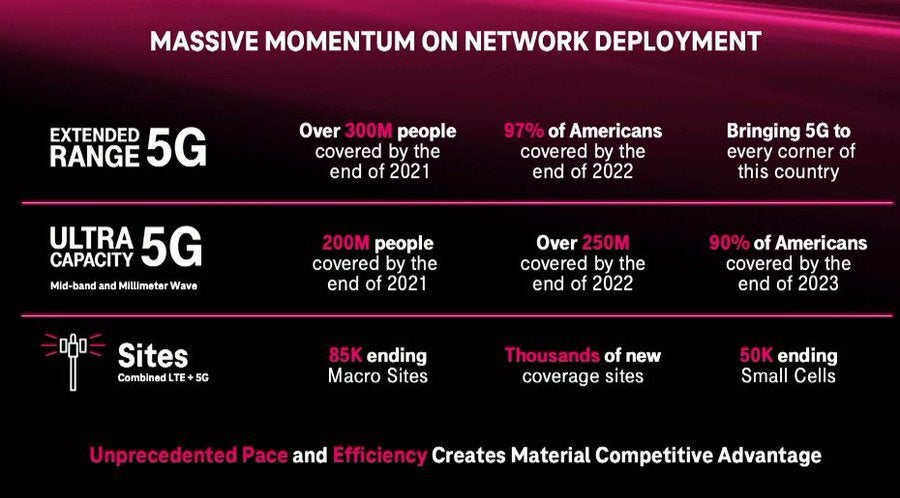T-Mobile currently boasts very fast median 5G download speeds and the widest 5G coverage, even though Verizon is able to achieve similar speeds with its newfangled C-band 4G network, and way better LTE coverage overall. Still, while Verizon and AT&T just shelled out big bucks for spectrum that will allow them to catch up to T-Mobile’s layer cake approach made possible by the merger with Sprint, the Un-carrier has a head start, and aims to keep it.
T-Mobile 5G network coverage plans by 2023
- 97% of Americans with slow ‘Extended Range 5G’ by the end of 2022
- 90% of Americans with faster 300Mbps-400Mbps 5G network by the end of 2023
T-Mobile said at its virtual investor conference that 97%t of Americans will have 5G access by the end of next year. What it mentioned, however, is that this coverage will be of the slow low-band variety that doesn’t give tangible speed benefits compared to 4G service. It won’t be before the end of 2023 that it will blanket 90% of Americans with the faster mid- and high-band Ultra Capacity 5G that now covers about a third of Americans.
T-Mobile’s 5-year 5G network plan
Maintaining 5G leadership in the 5G era
- Recent C band investment further positions T-Mobile’s superiority for 5G era.
- Already delivering 5G across more geographic coverage than AT&T and Verizon combined.
- Only operator to have deployed dedicated mid-band spectrum for 5G.
Significantly expanding addressable markets
- T-Mobile’s superior 5G network to unlock growth opportunities in new markets, deepen relationships with customers and take the competition to cable.
- Plans to increase share of smaller markets and rural areas to nearly 20% in next 5 years.
- Expect to double market share in enterprise in next 5 years.
- Bring competition to the $90 billion broadband market, targeting 7-8 million customers in 5 years.
Unlocking bigger merger synergies, faster
- Expect total net present value of merger synergies to be more than $70 billion – up more than 60% from original merger guidance of $43 billion.
- Expect total run rate cost synergies to reach ~$7.5 billion per year by 2024 – up 25% from original merger guidance of $6 billion per year.
Delivering better financial results
- Raising mid-term and long-term guidance across the board w/ higher service revenue, Core Adjusted EBITDA and free cash flow.
- Potentially up to $60 billion in shareholder return between 2023-2025.


